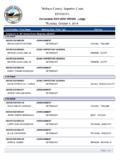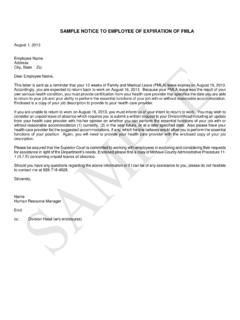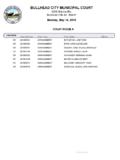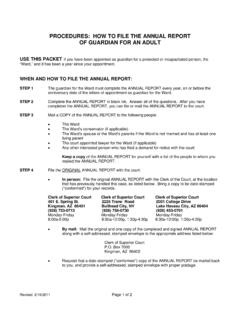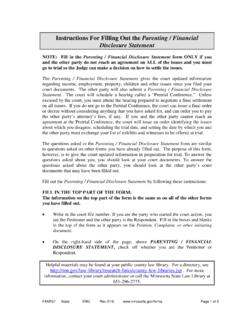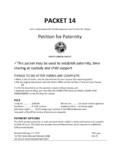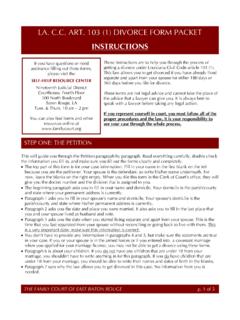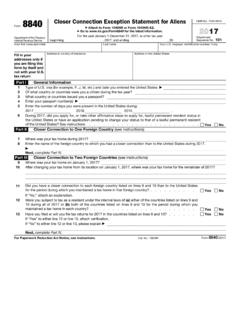Transcription of INSTRUCTIONS: HOW TO FILL OUT THE “WITNESS AND …
1 Revised: 1/1/2013 1 of 3 instructions : HOW TO fill OUT THE WITNESS AND EXHIBIT LIST USE THIS FORM ONLY if a petition /complaint and an answer/response have been filed in your case. By filing a Witness and Exhibit List , you are telling the court that you want a trial, and you want to tell the court, and the other party, who your witnesses are and what exhibits you will use at the trial. Here are the instructions and a step-by-step guide to filling out the Witness and Exhibit List. STEP 1: CHOOSING YOUR WITNESSES AND EXHIBITS.
2 If you intend to use a witness or an exhibit at trial, you must be prepared to tell the judge why the testimony of the witness(es), or the exhibits are important to your case. WITNESSES. You should think in terms of what you want to say to the judge and what the witness(es) will be able to tell the judge to help your case. Witnesses are people who will help you tell your story to the judge. They should be people who can talk to the judge, under oath, about things they have seen, or know personally, not things they have heard about from you, or someone else.
3 EXHIBITS. An exhibit can be any object, paper, photograph, receipt, letter or document that reveals to the judge, something relevant to your case. Be sure when you make your list, that it is clear to the other party, and the judge, who, or what specifically, you are referring to. DOMESTIC RELATIONS CASES ONLY: 1. CHILDREN AS WITNESSES: Many people, especially those involved in legal decision making disputes, want to put children on their list of witnesses. Judges generally will not allow children under the age of 18 to be called as a witness in court.
4 Putting a child on the witness stand puts that child in the very awkward position of choosing between mom and dad. Keep this in mind when deciding which witness(es) you want to list for your case. 2. COMMON WITNESSES AND EXHIBITS: The following are issues that may be relevant to your case, and witnesses or exhibits commonly used at trial. They are designed to give you ideas, not to tell you who, or what, you should, or should not, list. If you are confused or need help, see a lawyer. If an issue does not apply to you, skip over it. LEGAL DECISION MAKING.
5 If legal decision making is in dispute, you will need to think about who can come to court to testify to the judge why it is in the best interests of the child(ren) to be with you. For example, you may want to call as witnesses, a teacher, day care worker, or close friend, who can tell the judge how you are caring for the child(ren)'s physical, emotional and/or psychological needs. You may also want to call family members as witnesses, but remember that a judge generally views a professional, or non-biased third party, more believable than a family member.
6 Exhibits you may want to consider using include report cards, school progress reports, reports of doctors or psychologists, and medical reports. VISITATION. If you are asking that the other party's visitation be supervised or restricted, you may want evidence to support your belief that it is in the child(ren)'s best interests to have supervised visitation. For example, if your witness(es) can testify to domestic violence or if you have other types of evidence, such as medical or police reports, you should include them in your list.
7 CHILD SUPPORT AND SPOUSAL MAINTENANCE/SUPPORT (ALIMONY). You will be required to fill out several documents relating to child support, including one most commonly referred to as an Affidavit of Financial Information , and a Revised: 1/1/2013 2 of 3 Parent s Worksheet. However, in order to prove earnings of yourself or the other party, you may want to include individual or joint tax returns, W2's, or other earning information, on your list of exhibits. If you do not have specific exhibits to list regarding the other party s work skills or experience, you may want to include witnesses who can testify to these issues.
8 You should also list, as evidence, day care or medical expenses paid on behalf of the child(ren), so the correct amount of child support can be ordered. PROPERTY AND DEBTS. If there is property and/or debts to be divided, you should include financial information on your list. For example, you should list credit card bills, mortgage information, personal loans, bank statements, including checking or savings balances, or any other documents that relate directly to your financial situation.
9 STEP 2: FILLING OUT THE WITNESS AND EXHIBIT LIST : Make sure your form is titled Witness and Exhibit List. Type or print using black ink only. A. In the top left corner of the first page provide the following information: Your Name; Address; City; State; Zip Code; Telephone Number; and your ATLAS Number, if you are receiving, or have received, AFDC from the Arizona Department of Economic Security. Mark the correct box(s) if you are representing yourself, or if an attorney is representing you as the Petitioner or the Respondent.
10 B. fill in YOUR name in the space that says "Name of Petitioner/Plaintiff" if you filed the original action. If the other party filed the original action, put their name as the Petitioner/Plaintiff. In the space that says "Name of Respondent/Defendant," fill in the name of the other party. These names will be used consistently throughout your case. Whoever was the Petitioner/Plaintiff for the original action will be the Petitioner/ Plaintiff for all other papers related to this case. And whoever was the Respondent/Defendant for the original action, will be the Respondent/ Defendant for all other papers related to this case.


